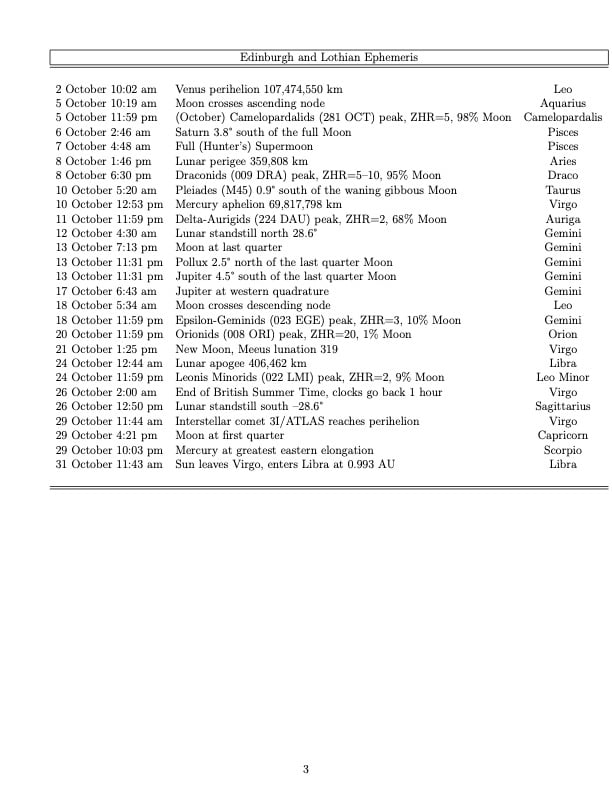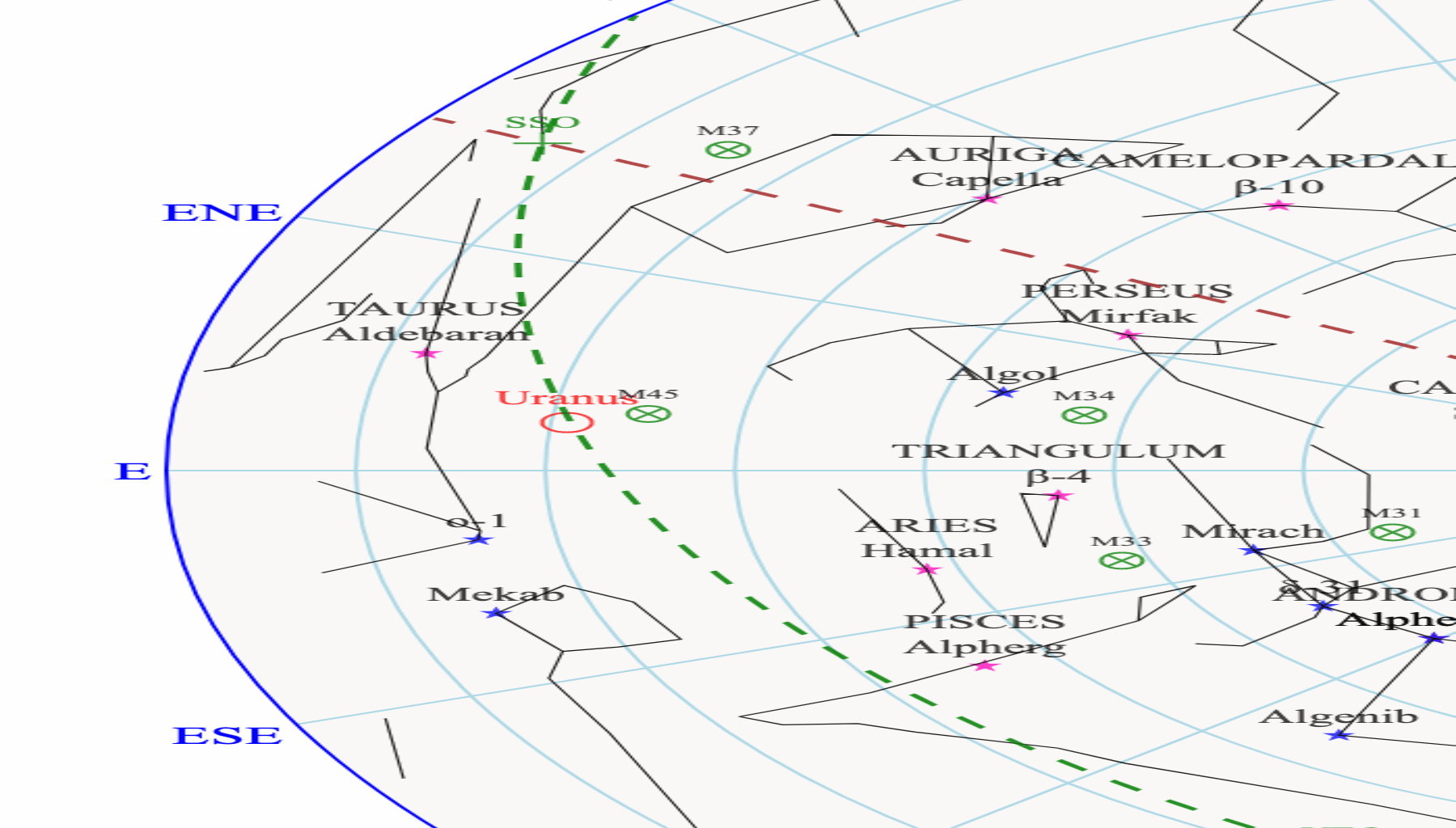The first of three consecutive supermoons appear and British Summer Time ends on 26 October.
The Sun passes from Virgo (The Maiden) on 31 October 11:43 am and enters Libra
(The Scales) and comes closer by 1,294,491 km over the whole month. Daylight
shortens from 11:31 (11.524 hours) on 1 October to 09:16 (9.269 hours) on 31
October so we gain 2 hours and 15 minutes of night time, by the end of the
month.
The Moon begins the month in Sagittarius (The Archer) and ends in Aquarius (The
Water Bearer) coming closer to Earth by 16,643 km. The full Hunter’s Moon
appears first on 7 October at 4:48 am in Pisces (The Fishes). Since it is at
‘perigee syzygy’, it is also a supermoon so fishing folk can expect larger
tides. Lunar perigee (closest to Earth) on 8 October at 1:46 pm finds the Moon
some 359,808 km away from Earth—around 24,592 km closer than
average—subtending an angle of 33.2 arc-minutes. This is followed by last
quarter on 13 October at 7:13 pm in Gemini (The Twins). The new Moon appears on
21 October at 1:25 pm in Virgo (The Maiden) beginning a new synodic (Lunar)
month which will last 29 days, 18 hours and 22 minutes. Lunar apogee (furthest
from Earth) occurs on 24 October at 12:44 am and takes the Moon to 406,462 km
away from Earth—around 22,062 km further than average—subtending an angle
of 29.4 arc-minutes. Finally, the first quarter of the new Lunar cycle shows up
on 29 October at 4:21 pm in Capricornus (The Sea Goat).
On 10 October, the Pleiades in Taurus (The Bull) will be 0.9 degrees south of the
waning gibbous Moon before sunrise. On 13 October, the first quarter Moon will
rise between Pollux and Jupiter in Gemini (The Twins) just before midnight.
For the inferior planets: Mercury begins the month in Virgo (The Maiden) and
ends in Scorpio (The Scorpion) but comes closer by 58,760,922 km (0.39AU). The
‘Swift Planet’ decreases in magnitude from -0.52 to -0.10 (1.47 times in
brightness). Mercury passes through another aphelion (furthest from the Sun) on
10 October and reaches greatest eastern elongation on 29 October. Venus begins
the month in Leo (The Lion) and ends in Virgo (The Maiden) but recedes by
16,544,626 km (0.11AU). The ‘Morning Star Planet’ lives up to the epithet by
shining brightly, but low in the eastern sky, at -3.9 magnitudes in the hour
before sunrise. Venus reaches perihelion (closest to the Sun) on 2 October.
For the superior planets: Mars begins the month in Virgo (The Maiden) and ends
in Libra (The Scales) but recedes by 7,891,929 km (0.05AU). The ‘Red Planet’
Mars increases in magnitude from 1.57 to 1.46 (1.11 times in brightness)
throughout October. Jupiter remains in Gemini (The Twins) all month but comes
closer by 70,873,488 km (0.47AU). The ‘Gas Giant’ increases in magnitude from
-2.12 to -2.32 (1.20 times in brightness) over the month. Jupiter reaches
western quadrature on 17 October meaning the angle between Sun, Earth and
planet is exactly 90 degrees.
Saturn begins the month in Pisces (The Fishes) and ends in Aquarius (The Water
Bearer) but recedes by 33,997,930 km (0.23AU). The ‘Ringed Planet’ decreases in
magnitude from 0.62 to 0.77 (1.15 times in brightness) over October. On 6
October, Saturn will be 3.8 degrees south of the full Moon in the small hours.
Uranus remains in Taurus (The Bull) but comes closer by 47,171,766 km (0.32AU).
Neptune remains in Pisces (The Fishes) but recedes by 32,086,578 km (0.22AU).
There are 6 meteor showers visible in October as detailed in the ephemeris.
Observability is a balance between ‘zenith hourly rate’ (the number of shooting
stars per hour if the radiant point were directly overhead) and Moon
illumination. So, we can rule out the Camelopardalids (281 OCT), the Draconids
(009 DRA) and the delta-Aurigids (224 DAU) because of a combination of both
factors. The epsilon-Geminids (023 EGE) has a very low ZHR but the waning
crescent Moon is illuminated to only 10%. It might be worth checking them out
on 18 October.
Our best show is reserved for the Orionids (008 ORI), peaking on 20 October,
with a ZHR of 20. The waning crescent Moon is barely illuminated as the new
Moon appears within half a day so viewing should be excellent. The parent comet
is the most famous of them all: 1/P Halley. The radiant point is close to
another famous object: Betelgeuse in Orion (The Hunter).
Finally, on 24 October we have the Leonis Minorid (022 LMI) meteor shower with
a ZHR of 2. This meteor shower has the distinction of being the first found in
photographic orbital data and the parent body is comet C/1739 K1 (Zanotti). The
radiant point is between the hind legs of Ursa Major (The Great Bear) so is
circumpolar. Although activity is low, the waxing crescent Moon is still
emerging from new so is illuminated only 9%.
20–23 October could be spectacular observing nights if the Edinburgh and
Lothian weather behaves. Not only could we witness the peak of the Orionids
mentioned above but two comets may reach naked-eye brightness. First comet
C/2025 R2 (SWAN)—only discovered on 12 September—will be 0.27 AU from the
Earth in Sagittarius (The Archer). Comet C/2025 A6 (Lemmon) will be 0.6 AU from
Earth in Serpens Cauda (The Serpent’s Head). Both comets should be viewed a
couple of hours after sunset. Not visible is our cosmic interloper, comet
3I/ATLAS, which passes perihelion on 29 October at 11:44 am.
At the time of our sky map, some constellations visible are Cepheus (The King)
at zenith, Ursa Major (The Great Bear) in the north, Perseus (The Hero) in the
east, Corona Borealis (The Northern Crown) in the west (which contains our
elusive recurrent nova known as the Blaze star) and Pegasus (The Winged Horse)
in the south. The ecliptic hosts Taurus (The Bull), Aries (The Ram), Pisces
(The Fishes), Aquarius (The Water Bearer), Capricorn (The Sea Goat) and
Sagittarius (The Archer).
The ‘Summer Triangle’—Vega in Lyra (The Lyre), Altair in Aquila (The Eagle)
and Deneb in Cygnus (The Swan)—is prominent in the south-west. The ‘Winter
Triangle’—Procyon in Canis Minor (The Lesser Dog), Sirius in Canis Major (The
Greater Dog) and Betelgeuse in Orion (The Hunter) rises in the wee, small
hours. Circumpolar constellations—always above the horizon—include
Camelopardalis (The Giraffe), Cassiopeia (The Seated Queen) and Draco (The
Dragon).


Phil Daly is a former employee of the Royal Observatory Edinburgh (now UKATC) on Blackford Hill.
He has worked on the UK’s overseas telescopes in Hawaii (UKIRT, JCMT) and on large telescopes
at major astronomical observatories worldwide. He is currently part of an international collaboration
searching for optical counterparts to gravity wave events using multi-messenger astronomy.
Like this:
Like Loading…
Related
